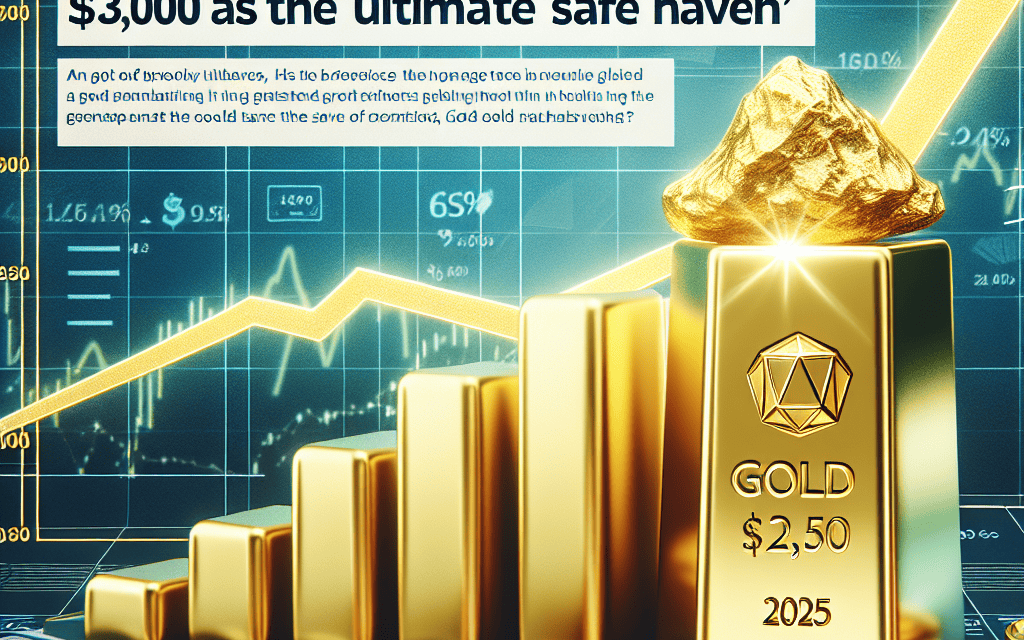“Bank of America Analyst Foresees Gold Soaring to $3,000 by 2025: The Ultimate Safe Haven Investment”
Introduction
In a recent analysis, a Bank of America analyst has projected that gold prices could soar to $3,000 per ounce by 2025, positioning the precious metal as the “ultimate safe haven” for investors. This forecast comes amid ongoing economic uncertainties and geopolitical tensions, which have historically driven investors towards gold as a reliable store of value. The analyst’s prediction underscores the potential for significant appreciation in gold prices, driven by factors such as inflationary pressures, currency fluctuations, and global market volatility. As traditional financial markets face increasing instability, gold’s enduring appeal as a hedge against risk and a safeguard for wealth preservation is expected to attract heightened interest from both institutional and individual investors.
Gold’s Role as a Safe Haven in Economic Uncertainty
In recent years, the global economic landscape has been marked by significant volatility and uncertainty, prompting investors to seek refuge in assets that promise stability and security. Among these, gold has consistently emerged as a preferred choice, often regarded as the ultimate safe haven. This perception is not without merit, as gold has historically maintained its value through economic downturns, geopolitical tensions, and currency fluctuations. In this context, a recent prediction by a Bank of America analyst that gold could reach $3,000 per ounce by 2025 has garnered considerable attention, underscoring the metal’s enduring appeal in times of economic uncertainty.
The rationale behind this optimistic forecast is multifaceted, reflecting a confluence of factors that are likely to drive demand for gold in the coming years. Firstly, the persistent threat of inflation looms large on the horizon. As central banks around the world continue to implement expansive monetary policies to stimulate growth in the wake of the COVID-19 pandemic, concerns about rising inflation have intensified. Gold, traditionally viewed as a hedge against inflation, is expected to benefit from this environment as investors seek to preserve their purchasing power.
Moreover, geopolitical tensions and global economic instability further bolster gold’s status as a safe haven. In an era characterized by trade disputes, political unrest, and shifting alliances, the demand for assets that offer security and stability is likely to increase. Gold’s intrinsic value and universal acceptance make it an attractive option for investors looking to mitigate risks associated with geopolitical uncertainties.
In addition to these macroeconomic factors, the dynamics of supply and demand also play a crucial role in shaping gold’s future trajectory. On the supply side, gold production faces challenges due to declining ore grades and increased regulatory scrutiny, which could constrain output in the coming years. Meanwhile, demand for gold is expected to rise, driven by both traditional and emerging markets. In countries like India and China, cultural affinity for gold continues to fuel consumption, while in developed economies, institutional investors are increasingly incorporating gold into their portfolios as a strategic asset.
Furthermore, technological advancements and innovations in the financial sector are likely to enhance gold’s accessibility and appeal. The rise of digital platforms and products, such as gold-backed exchange-traded funds (ETFs) and blockchain-based gold tokens, has made it easier for investors to buy and sell gold, thereby broadening its market reach. This increased accessibility is expected to attract a new generation of investors who value the convenience and security offered by digital assets.
While the prediction of gold reaching $3,000 per ounce by 2025 is ambitious, it is not without precedent. Historical trends demonstrate that gold prices have experienced significant surges during periods of economic turmoil. As such, the current global environment, characterized by uncertainty and instability, provides fertile ground for a potential rally in gold prices.
In conclusion, gold’s role as a safe haven asset is likely to be reinforced in the coming years, driven by a combination of inflationary pressures, geopolitical tensions, supply constraints, and increased demand. As investors navigate an uncertain economic landscape, gold’s enduring appeal as a store of value and a hedge against risk is expected to remain strong. The Bank of America analyst’s prediction serves as a reminder of gold’s timeless allure and its potential to reach new heights in the face of global challenges.
Factors Driving Gold Prices to New Heights
The recent prediction by a Bank of America analyst that gold prices could soar to $3,000 by 2025 has captured the attention of investors and market observers alike. This forecast is rooted in a confluence of factors that are currently shaping the global economic landscape, making gold an increasingly attractive asset. As the ‘ultimate safe haven,’ gold has historically been a refuge for investors during times of economic uncertainty, and several key elements are contributing to its potential rise in value.
Firstly, the ongoing geopolitical tensions across various regions of the world are playing a significant role in driving investors towards gold. Conflicts and diplomatic strains often lead to market volatility, prompting investors to seek stability in assets that are less susceptible to geopolitical risks. Gold, with its intrinsic value and historical resilience, becomes a preferred choice during such times. As these tensions show no signs of abating, the demand for gold is likely to remain strong, supporting its price trajectory.
In addition to geopolitical factors, the global economic environment is also influencing gold prices. Central banks around the world have adopted accommodative monetary policies in response to economic slowdowns and inflationary pressures. Low interest rates and quantitative easing measures have led to increased liquidity in the financial system, which can diminish the value of fiat currencies. As a result, investors often turn to gold as a hedge against currency depreciation and inflation. The expectation of continued monetary easing in major economies further bolsters the case for rising gold prices.
Moreover, the uncertainty surrounding the global economic recovery from the COVID-19 pandemic continues to impact investor sentiment. While some economies have shown signs of recovery, others are still grappling with the pandemic’s aftermath. This uneven recovery has led to concerns about the sustainability of economic growth, prompting investors to diversify their portfolios with assets like gold that are perceived as more stable. The lingering effects of the pandemic, coupled with potential future disruptions, add another layer of support for gold’s appeal as a safe haven.
Furthermore, the increasing interest in sustainable and ethical investing is also contributing to the demand for gold. Investors are becoming more conscious of the environmental and social impacts of their investments, and gold, when sourced responsibly, aligns with these values. The growing trend towards sustainable investing is likely to enhance gold’s attractiveness, as it offers a tangible asset that can be part of a diversified and ethically aligned portfolio.
In conclusion, the prediction that gold could reach $3,000 by 2025 is underpinned by a complex interplay of geopolitical, economic, and social factors. As the world navigates through uncertain times, gold’s status as the ‘ultimate safe haven’ is reinforced by its ability to provide stability and security to investors. While the future is inherently unpredictable, the current trajectory suggests that gold will continue to be a focal point for those seeking refuge from volatility and uncertainty. As these dynamics unfold, the precious metal’s allure is likely to persist, potentially driving its price to new heights in the coming years.
Bank of America’s Gold Price Prediction: An Analysis
In recent developments within the financial markets, a Bank of America analyst has made a bold prediction that gold prices could soar to $3,000 per ounce by 2025. This forecast has captured the attention of investors and market observers alike, as it suggests a significant upward trajectory for the precious metal, often regarded as the “ultimate safe haven.” To understand the implications of this prediction, it is essential to delve into the factors driving this optimistic outlook and the potential impact on global markets.
Historically, gold has been perceived as a reliable store of value, particularly during times of economic uncertainty and geopolitical instability. Its intrinsic value and limited supply make it an attractive asset for investors seeking to hedge against inflation and currency devaluation. In recent years, these concerns have been exacerbated by unprecedented monetary policies, including quantitative easing and low interest rates, implemented by central banks worldwide in response to economic challenges. Consequently, the demand for gold has surged as investors seek refuge from potential financial turbulence.
The Bank of America analyst’s prediction is rooted in several key factors that are expected to influence gold prices in the coming years. Firstly, the ongoing global economic recovery from the COVID-19 pandemic remains fragile, with many countries grappling with inflationary pressures and supply chain disruptions. These challenges have heightened fears of prolonged economic instability, prompting investors to turn to gold as a safeguard against potential downturns. Additionally, geopolitical tensions, such as those involving major powers and regional conflicts, continue to pose risks to global stability, further bolstering gold’s appeal as a safe haven asset.
Moreover, the analyst highlights the role of central bank policies in shaping the future trajectory of gold prices. As inflationary pressures mount, central banks may face difficult decisions regarding interest rates and monetary tightening. Should these institutions opt to maintain accommodative policies to support economic growth, the resulting environment of low real interest rates could further enhance the attractiveness of gold as an investment. Conversely, any aggressive tightening measures could lead to market volatility, driving investors towards gold as a hedge against potential financial market disruptions.
In addition to these macroeconomic factors, the analyst points to the growing interest in gold from institutional investors and central banks. In recent years, there has been a notable increase in gold purchases by central banks, particularly in emerging markets, as they seek to diversify their reserves and reduce reliance on the US dollar. This trend is expected to continue, providing additional support for gold prices. Furthermore, institutional investors, including hedge funds and asset managers, have increasingly recognized the strategic value of gold in portfolio diversification, further driving demand.
While the prediction of gold reaching $3,000 per ounce by 2025 is ambitious, it is not without precedent. Gold prices have experienced significant rallies in the past, often driven by similar economic and geopolitical factors. However, it is important to acknowledge the inherent uncertainties and risks associated with such forecasts. Market dynamics can be influenced by a myriad of unpredictable events, and investors should exercise caution and conduct thorough research before making investment decisions based on price predictions.
In conclusion, the Bank of America analyst’s forecast of gold reaching $3,000 per ounce by 2025 underscores the enduring appeal of the precious metal as a safe haven asset. As global economic and geopolitical uncertainties persist, gold’s role as a hedge against inflation and financial instability remains paramount. While the path to this price target may be fraught with challenges, the underlying factors driving this prediction warrant careful consideration by investors and market participants alike.
Historical Trends in Gold Prices and Future Projections

Gold has long been regarded as a reliable store of value, often referred to as the “ultimate safe haven” during times of economic uncertainty. Historically, gold prices have been influenced by a myriad of factors, including inflation rates, currency fluctuations, and geopolitical tensions. Over the past few decades, gold has demonstrated a remarkable ability to retain its value, even as other assets have experienced significant volatility. This enduring appeal has led analysts to continually assess its future trajectory, with recent predictions suggesting a potential surge in gold prices.
In recent years, the global economic landscape has been marked by unprecedented challenges, including the COVID-19 pandemic, supply chain disruptions, and rising inflation. These factors have contributed to increased investor interest in gold as a hedge against economic instability. As a result, gold prices have experienced notable fluctuations, reaching record highs in 2020 before stabilizing in subsequent years. However, the prospect of further economic uncertainty has led some analysts to predict a significant rise in gold prices in the coming years.
One such prediction comes from a Bank of America analyst, who has forecasted that gold could reach $3,000 per ounce by 2025. This projection is based on several key factors that are expected to drive demand for gold in the near future. Firstly, the ongoing concerns about inflation are likely to persist, as central banks around the world continue to implement expansive monetary policies. These policies, while aimed at stimulating economic growth, have the potential to erode the purchasing power of fiat currencies, thereby increasing the appeal of gold as a hedge against inflation.
Moreover, geopolitical tensions remain a significant driver of gold prices. In recent years, conflicts and diplomatic disputes have created an environment of uncertainty, prompting investors to seek refuge in safe-haven assets like gold. As these tensions show no signs of abating, the demand for gold is expected to remain robust, further supporting the upward trajectory of its price.
In addition to these factors, the growing interest in sustainable and ethical investing is also likely to impact gold prices. As investors become more conscious of environmental and social governance (ESG) criteria, the demand for responsibly sourced gold is expected to rise. This shift in investor preferences could lead to increased scrutiny of gold mining practices, potentially affecting supply and, consequently, prices.
While the prediction of gold reaching $3,000 per ounce by 2025 is ambitious, it is not without precedent. Historical trends have shown that gold prices can experience significant surges during periods of economic turmoil. For instance, during the global financial crisis of 2008, gold prices nearly doubled as investors flocked to the safety of precious metals. Similarly, the uncertainty surrounding the COVID-19 pandemic led to a sharp increase in gold prices in 2020.
In conclusion, the forecast of gold reaching $3,000 per ounce by 2025 is grounded in a confluence of factors that are expected to drive demand for this precious metal. As inflationary pressures persist, geopolitical tensions continue, and sustainable investing gains traction, gold’s status as the “ultimate safe haven” is likely to be reinforced. While the future is inherently uncertain, the historical resilience of gold suggests that it will continue to play a crucial role in the portfolios of investors seeking stability in an ever-changing economic landscape.
Investment Strategies for a Potential Gold Surge
In recent years, the financial markets have been characterized by volatility and uncertainty, prompting investors to seek refuge in assets that promise stability and security. Among these, gold has consistently emerged as a preferred choice, often regarded as the ultimate safe haven. This perception is further reinforced by a recent prediction from a Bank of America analyst, who suggests that gold prices could soar to $3,000 per ounce by 2025. Such a forecast has significant implications for investment strategies, particularly for those looking to capitalize on a potential surge in gold prices.
To understand the rationale behind this prediction, it is essential to consider the factors that typically drive gold prices. Historically, gold has been a hedge against inflation, currency devaluation, and geopolitical instability. In the current global economic climate, these factors are more relevant than ever. Inflation rates are rising in many parts of the world, driven by supply chain disruptions and expansive fiscal policies. Concurrently, geopolitical tensions, such as those involving major powers, continue to create an atmosphere of uncertainty. These conditions collectively enhance gold’s appeal as a stable store of value.
Moreover, central banks around the world have been increasing their gold reserves, a trend that underscores the metal’s enduring allure. This accumulation is partly a response to the need for diversification away from traditional reserve currencies, which are subject to fluctuations and potential devaluation. As central banks bolster their gold holdings, the demand for the metal is likely to rise, exerting upward pressure on prices. This dynamic is further compounded by the limited supply of gold, which cannot be rapidly increased to meet growing demand.
For investors, the prospect of gold reaching $3,000 per ounce presents both opportunities and challenges. On one hand, those who already hold gold in their portfolios may benefit from significant capital appreciation. On the other hand, investors who are considering entering the gold market must carefully evaluate their timing and strategy. It is crucial to recognize that while gold is a relatively stable asset, it is not immune to price fluctuations. Therefore, a well-considered approach is necessary to maximize potential gains while mitigating risks.
One potential strategy is to adopt a diversified investment approach that includes a mix of physical gold, such as bullion or coins, and gold-related financial instruments, like exchange-traded funds (ETFs) or mining stocks. Physical gold offers the advantage of tangible ownership, while ETFs and mining stocks provide liquidity and the potential for additional returns through dividends or capital gains. By balancing these different forms of gold investment, investors can tailor their portfolios to align with their risk tolerance and investment objectives.
Furthermore, it is advisable for investors to stay informed about macroeconomic trends and geopolitical developments, as these factors can significantly influence gold prices. Regularly reviewing and adjusting investment strategies in response to changing conditions can help investors navigate the complexities of the gold market.
In conclusion, the prediction that gold could reach $3,000 per ounce by 2025 highlights the metal’s enduring role as a safe haven asset. For investors, this presents an opportunity to reassess their portfolios and consider strategies that leverage gold’s potential for growth. By understanding the underlying drivers of gold prices and adopting a diversified approach, investors can position themselves to benefit from a potential surge in the value of this timeless asset.
Comparing Gold with Other Safe Haven Assets
In the ever-evolving landscape of global finance, the quest for safe haven assets remains a critical consideration for investors seeking to protect their wealth against economic uncertainties. Recently, a Bank of America analyst made headlines by predicting that gold could reach an unprecedented $3,000 per ounce by 2025, positioning it as the “ultimate safe haven.” This bold forecast invites a closer examination of gold’s role compared to other traditional safe haven assets, such as government bonds, the U.S. dollar, and cryptocurrencies, in the context of current economic conditions.
To begin with, gold has long been revered for its intrinsic value and historical significance as a store of wealth. Its appeal as a safe haven is largely attributed to its ability to retain value during periods of inflation, currency devaluation, and geopolitical instability. Unlike fiat currencies, gold is not subject to the whims of central banks or government policies, making it a reliable hedge against economic turmoil. The Bank of America analyst’s prediction underscores the metal’s enduring allure, particularly in an era marked by unprecedented monetary stimulus and rising inflationary pressures.
In contrast, government bonds, particularly those issued by stable economies like the United States, have traditionally been considered safe haven assets due to their low risk and predictable returns. However, the current low-interest-rate environment has diminished their appeal. With yields on many government bonds hovering near historic lows, investors are increasingly questioning their ability to provide adequate protection against inflation. This shift in sentiment has prompted some to explore alternative safe havens, such as gold, which offers the potential for capital appreciation in addition to its defensive qualities.
Meanwhile, the U.S. dollar has historically served as a global reserve currency and a refuge during times of crisis. Its strength is often seen as a barometer of global economic confidence. However, the dollar’s status as a safe haven is not without challenges. The ongoing expansion of the U.S. money supply, coupled with concerns about the country’s fiscal health, has led some investors to seek diversification away from dollar-denominated assets. In this context, gold’s appeal as a non-correlated asset becomes even more pronounced, offering a hedge against potential dollar depreciation.
Furthermore, the rise of cryptocurrencies, particularly Bitcoin, has introduced a new dimension to the safe haven debate. Proponents argue that digital currencies offer a decentralized and inflation-resistant alternative to traditional assets. However, the volatility and regulatory uncertainties surrounding cryptocurrencies have raised questions about their suitability as reliable safe havens. While Bitcoin has been dubbed “digital gold” by some, its lack of a long-term track record and susceptibility to market fluctuations make it a less predictable option compared to physical gold.
In conclusion, the Bank of America analyst’s prediction that gold could reach $3,000 by 2025 highlights the metal’s enduring status as a premier safe haven asset. As investors navigate an increasingly complex financial landscape, the comparative advantages of gold over other traditional and emerging safe havens become evident. While government bonds and the U.S. dollar continue to play important roles in diversified portfolios, the unique attributes of gold—its historical resilience, independence from monetary policy, and potential for appreciation—solidify its position as a cornerstone of wealth preservation strategies. As the world grapples with economic uncertainties, gold’s allure as the “ultimate safe haven” remains as compelling as ever.
The Impact of Global Economic Policies on Gold Prices
The global economic landscape is a complex web of interrelated factors, each influencing the other in myriad ways. Among these, the policies enacted by governments and central banks play a pivotal role in shaping the financial markets. One asset that has historically been sensitive to such policies is gold, often regarded as the ultimate safe haven. Recently, a Bank of America analyst predicted that gold prices could soar to $3,000 per ounce by 2025, a forecast that underscores the potential impact of current and future economic policies on this precious metal.
To understand this prediction, it is essential to consider the broader economic context. Central banks around the world have adopted unprecedented monetary policies in response to economic challenges, such as the COVID-19 pandemic and geopolitical tensions. These policies, including low interest rates and quantitative easing, have led to increased liquidity in the financial system. While these measures aim to stimulate economic growth, they also raise concerns about inflation and currency devaluation. In such an environment, investors often turn to gold as a hedge against inflation and a store of value, driving up its demand and price.
Moreover, fiscal policies also play a crucial role in influencing gold prices. Governments have implemented expansive fiscal measures, including stimulus packages and infrastructure spending, to support their economies. While these initiatives can boost economic activity, they also contribute to rising national debts. The potential for increased taxation and reduced government spending in the future to manage these debts can create economic uncertainty. Gold, with its historical reputation as a safe haven during times of uncertainty, becomes an attractive investment option, further supporting its price.
In addition to monetary and fiscal policies, geopolitical factors significantly impact gold prices. Tensions between major economies, such as the United States and China, can lead to market volatility and uncertainty. In such scenarios, investors often seek refuge in gold, driving up its demand. Furthermore, the ongoing global shift towards de-dollarization, where countries seek to reduce their reliance on the US dollar, can also influence gold prices. As nations diversify their reserves away from the dollar, gold becomes a preferred alternative, potentially boosting its value.
The interplay between these economic policies and gold prices is further complicated by the dynamics of supply and demand. Gold mining production has remained relatively stable, with limited new discoveries and increasing extraction costs. This constrained supply, coupled with rising demand driven by economic policies and geopolitical factors, creates a favorable environment for higher gold prices.
While the prediction of gold reaching $3,000 by 2025 is speculative, it highlights the potential impact of global economic policies on this precious metal. Investors and policymakers alike must remain vigilant, considering the multifaceted influences that drive gold prices. As the world navigates through economic uncertainties, gold’s role as the ultimate safe haven may become increasingly prominent, reflecting its enduring appeal in the face of evolving global challenges. In conclusion, the intricate relationship between global economic policies and gold prices underscores the importance of understanding these dynamics to make informed investment decisions in an ever-changing financial landscape.
Q&A
1. **What is the prediction made by the Bank of America analyst regarding gold prices?**
The Bank of America analyst predicts that gold prices could reach $3,000 per ounce by 2025.
2. **Why is gold considered the ‘ultimate safe haven’?**
Gold is considered the ‘ultimate safe haven’ because it is a tangible asset that tends to retain value during economic uncertainty, inflation, and geopolitical tensions.
3. **What factors are contributing to the potential rise in gold prices?**
Factors contributing to the potential rise in gold prices include economic instability, inflationary pressures, geopolitical tensions, and central bank policies.
4. **How does inflation impact gold prices?**
Inflation erodes the purchasing power of fiat currencies, making gold more attractive as a store of value, which can drive up its price.
5. **What role do central banks play in influencing gold prices?**
Central banks influence gold prices through their monetary policies, such as interest rate adjustments and quantitative easing, which can affect currency values and investor demand for gold.
6. **How might geopolitical tensions affect gold prices?**
Geopolitical tensions can lead to increased demand for gold as investors seek a safe haven to protect their assets from potential market volatility and uncertainty.
7. **What is the current trend in gold investment among investors?**
The current trend shows an increasing interest in gold investment as investors look to diversify their portfolios and hedge against economic and geopolitical risks.
Conclusion
The prediction by a Bank of America analyst that gold could reach $3,000 by 2025 underscores the metal’s enduring appeal as a safe-haven asset, particularly in times of economic uncertainty and market volatility. This forecast suggests that factors such as inflationary pressures, geopolitical tensions, and potential currency devaluation could drive investors towards gold as a means of preserving wealth. If these conditions persist or intensify, the demand for gold may increase, supporting the analyst’s projection. However, such predictions are inherently speculative and depend on numerous variables, including global economic trends and monetary policy decisions. Therefore, while the forecast highlights gold’s potential as a protective investment, it should be considered within the broader context of market dynamics and individual investment strategies.





